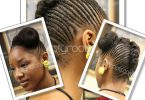If you want to learn to do cornrows you should probably watch an instructional video, as opposed to trying to follow the directions in a book. This is because this type of hairstyle is very particular, and truly an art form. This method of braiding hair dates back for some centuries; some even believe as far as 500 B.C. because there seems to be ancient evidence depicted in hieroglyphs and sculptures. In fact, the might Sphinx has similar looking decorations going around the back of his head.
The Egyptians are not the only people who are known to have used this hairstyle. It is also believed that cornrows, or at least the method by which they are braided, were present in Nigeria and Africa too. Africa, however, seems to be the agreed upon origin. Each region, however seemed to share a particular uniformity in the way they designed hair. While the basic upward underhand method of braiding may have been the same or similar, tribes or communities would often use their own symbols to designate where you came from. It was also common to use things like beads or shells that were native to your habitat, which further helped in determining where you came from.
As this is an ancient African tradition, it was definitely not introduced to North America until after the slave trade. Even then, the ability for native Africans to celebrate their culture was not allowed until after they were able to live freely. However, it wasn’t until the Black Pride Movement, and perhaps also the Civil Rights Movement of the 1960s that African Americans turned back time to embrace their more natural, traditional hairstyles.
Because of the intricate, delicate, artistic nature of the cornrow style, you had to learn this tradition from someone who was qualified to teach it, much like other family traditions in many cultures. Of course, now you can learn this skill in a beauty school, but that does also explain why you see many beauty salons that are particularly dedicated to black hairstyles—simply because they require the skilled hands of a practiced artisan.
The popularity of the cornrow is undergoing another revival with the rise of more black entertainment. As more African Americans break into successful places in television, movies, and music the need for traditional African identity grows too. As such, these performers use the simple design as a base for more individual characteristics.







i really need help learning to do cornrows will you send me a video